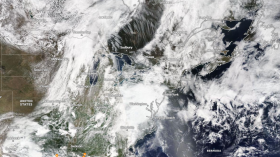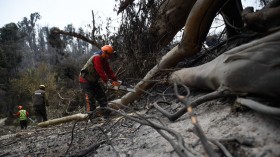Scientists from Sweden discovered that an enormous amount of methane, a powerful greenhouse gas, is leaking from unexpected depths of the Baltic Sea seabed.
The methane leak was discovered in the Landsort Deep (Landsortsdjupet), approximately 30 kilometers southeast of the coastal town of Nynäshamn.
During a recent voyage, researchers from Stockholm University and Linne University discovered methane bubbles rising 370 meters (1,200 feet) from the seafloor, much exceeding the expected 150-200 meters.
Intense bubble
The project's goal is to learn more about methane and its sources and sinks in the oxygen-free habitats of the Baltic Sea's deep waters. Marcelo Ketzer, a professor of environmental science at Linnaeus University, is in charge of the project.
Methane gas is produced by microorganisms living in the deep sediment layers of the seafloor and is discharged into the atmosphere by leaks in fossil fuel installations as well as other human-caused sources such as livestock farms and landfills.
While it is present in the atmosphere for a shorter amount of time, methane is 80 times more effective than carbon dioxide in terms of warming, accounting for around 30% of the worldwide rise in temperatures to date but being significantly less common in the environment.
"Knowledge about the factors that control how much methane is produced in these deeper areas and where the methane goes is limited. How does the system react to, for example, eutrophication or a warmer climate? I knew from one of my previous projects that the methane levels in the sediments in this area are higher than elsewhere in the Baltic Sea, but I never expected methane to bubble out into the sea in this way," says Marcelo Ketzer.
A vast number of sediment cores and water samples were gathered during the voyage, and the researchers now expect that future analysis will be able to provide answers as to why so much methane gas is emitted from this specific place.
Ketzer also noted that they have a solid sense of why it appears like that.
The size of the sediment grains in the area and the shape of the bottom provide clues.
Deep ocean currents appear to be driving sediment accumulation in this area, but more extensive analyses are needed before we can make any firm conclusions.
Read Also: Methane Leak: The Decade-Long Poisoning of the North Sea by a Major Gas Company
Bubbles rising to the surface
Another intriguing discovery revealed during the expedition involves the height to which methane bubbles climb in the water column.
"At the depths we are working with here, you can expect the methane bubbles to reach at most perhaps 150-200 meters from the seabed. The methane in the bubbles dissolves in the ocean and therefore they usually gradually decrease in size as they rise towards the sea surface," says Christian Stranne, associate professor of marine geophysics at Stockholm University.
According to the United Nations Environment Programme (UNEP), ruptures in the Nord Stream pipeline under the Baltic Sea last year resulted in the largest single discharge of methane ever recorded. Methane holds 80 times the amount of heat that carbon dioxide does.
Pipelines under the Baltic Sea were delivering natural gas from Russia to Germany when underwater explosions caused significant damage last September.
The United States and Russia have both accused each other of sabotage in connection with the incident, but investigations have yielded no convincing evidence of who was involved.
Related Article: Why the Nord Stream Methane Leak Can Threaten the Environment
Related Video:
© 2024 NatureWorldNews.com All rights reserved. Do not reproduce without permission.





![Wildfire Activity in Wet African Tropical Forests Exacerbated by Deforestation, Climate Change [Study]](https://1471793142.rsc.cdn77.org/data/thumbs/full/70409/280/157/50/40/wildfire-activity-in-wet-african-tropical-forests-exacerbated-by-deforestation-climate-change-study.jpg)
